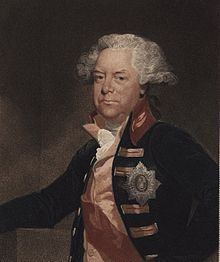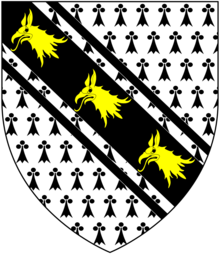Sir George Yonge, 5th Baronet
Sir George Yonge | |
|---|---|
 Portrait by Edmund Scott, 1790. | |
| Secretary at War | |
| In office 1783–1794 | |
| Monarch | George III |
| Preceded by | Richard FitzPatrick |
| Succeeded by | William Windham |
| In office 1782–1783 | |
| Monarch | George III |
| Preceded by | The Viscount Sydney |
| Succeeded by | Richard FitzPatrick |
| Governor ofthe Cape Colony | |
| In office 10 December 1799 – 20 April 1801 | |
| Monarch | George III |
| Preceded by | Francis Dundas |
| Succeeded by | Francis Dundas |
| Member of ParliamentforHoniton | |
| In office 1763–1796 | |
| Preceded by | Henry Reginald Courtenay |
| Succeeded by | George Chambers |
| In office 1754–1761 | |
| Preceded by | Sir William Yonge |
| Succeeded by | John Duke |
| Personal details | |
| Born | 17 July 1731 Great House,Colyton, Devon,England |
| Died | 25 September 1812(aged 81) Hampton Court Palace,Surrey,England |
| Resting place | Colyton, Devon, England |
| Spouse |
Ann Cleeve (m.1765) |
| Parent |
|
| Education | Eton College |
| Alma mater | University of Leipzig |
Sir George Yonge, 5th Baronet,KCB,PC,FRS(/jʌŋ/;17 July 1731 – 25 September 1812), ofEscot Housein the parish ofTalatoninDevon,England, was a BritishSecretary at War(1782–1783 and 1783–1794). He succeeded tohis father's baronetcyin 1755, which became extinct when he died without children. He isremembered by,among other things, the name ofYonge Street,a principal road in what is nowToronto,Canada, so named in 1793 by theLieutenant-Governor of Upper Canada,John Graves Simcoe.
Life and career
[edit]

Yonge was born in 1731[1]atGreat Housein the parish ofColyton, Devon,the son and heir ofSir William Yonge, 4th Baronetby his second wife Ann Howard. He had a stepbrother, Walter Yonge, from his father's first wife Mary Heathcote.
He was educated atEton Collegeand then at theUniversity of Leipzig.[2] He served as aMember of Parliamentfor his family'sRotten BoroughofHoniton,Devon, from 1754 to 1761 and again from 1763 to 1796. He was quoted to have often said that he had inherited £80,000 from his father, acquired another £80,000 when he married and £80,000 from Parliament but Honiton had "swallowed it all," This was due to the huge briberies which were commonplace to influence the electorate in rotten borough elections of the time. Yonge was appointed to thePrivy Council of the United Kingdomin 1782, and acted as Governor of theCape Colonyfor a short period from 1799 to 1801. He was elected aFellow of the Royal Societyin 1784[3]and was invested as aKnight of the Bathin 1788.
In 1755, he inheritedEscot Housenear Ottery St Mary, Devon, on the death of his father. In 1794, he sold it for £26,000 toSir John Kennaway, 1st Baronet,under whose occupancy it burnt down in 1808.
When Yonge died, indebted, on 25 September 1812 atHampton Court,the baronetcy died with him.[2]Initially he was interred at the place of his death but his remains were later exhumed and transported by sea to be laid to rest in the family crypt in the parish ofColyton.The re-burial was reputed to have taken place by night in fear that his creditors may seize the body.
Family
[edit]Yonge married Ann Cleeve, daughter and sole heir ofBourchier Cleeve,on 10 July 1765.[4]Yonge was then 34 years old and Ann 20 or perhaps just 21. Ann's father, two days before his death, changed his will[5][6]to place restrictions on Ann's inheritance should she marry someone whom her mother deemed inappropriate. Whether this occurred is not clear.
Ann had no children. She died at Hampton on 7 January 1833.[7]
There is great confusion in many sources, both online and in print, that give George Yonge's wife's name as Elizabeth. This seems to be a mistake. For a discussion, see thetalk page.
Legacy
[edit]
Yonge was considered an expert on Roman roads: 'He was a man of letters, an F.R.S., and a Fellow of the Society of Antiquaries, to which he communicated an excellent memoir on the subject of Roman roads and camps, in connection with some discoveries that had been made at Mansfied, in Nottinghamshire, and hence the peculiar fitness of naming Yonge Street after him, it being precisely such a road, and adapted to similar uses, as those he had been engaged in examining.[8]
Yonge Street, the main north–south street of Toronto, was built between 1795 and 1796 fromEglinton AvenuetoLake Simcoe.Later the road was extended south toBloor Streetand still later, south toLake Ontario.Yonge Mills Road and Townline Road Escott Yonge inFront of Yonge TownshipinMallorytown, Ontarioare named for him as well.
References
[edit]Leigh Rayment's list of baronets
- ^Other sources give 1732:Scadding, Henry (January 1878)."Yonge Street and Dundas Street: The Men after whom they were named".The Canadian Journal of Science, Literature and History.15(8): 616.Retrieved6 May2013.
- ^ab"Early Days in Richmond Hill: A History of the Community to 1930: electronic edition.: The Road through Richmond Hill".edrh.rhpl.richmondhill.on.ca.
- ^"Library and Archive catalogue".Royal Society.Retrieved27 February2012.
- ^Namier, Lewis (1985).The House of Commons 1754-1790.Boydell & Brewer.ISBN9780436304200.
- ^"Catalogue description Will of Bourchier Cleeve of Footscray Place, Kent".17 March 1760 – via National Archive of the UK.
- ^"Bourchier Cleeve".11 August 2017.
- ^"Morning Post".15 January 1833.
- ^Engineering.Office for Advertisements and Publication. 1879. p. 389.
External links
[edit]- 1731 births
- 1812 deaths
- People educated at Eton College
- Leipzig University alumni
- Baronets in the Baronetage of England
- British MPs 1754–1761
- British MPs 1761–1768
- British MPs 1768–1774
- British MPs 1774–1780
- British MPs 1780–1784
- British MPs 1784–1790
- British MPs 1790–1796
- British MPs 1796–1800
- Governors of the Cape Colony
- Knights Companion of the Order of the Bath
- Lords of the Admiralty
- Members of the Parliament of Great Britain for Honiton
- Members of the Privy Council of Great Britain
- Masters of the Mint
- Fellows of the Royal Society
- Members of the Parliament of the United Kingdom for Old Sarum
- UK MPs 1801–1802
